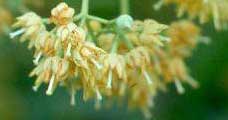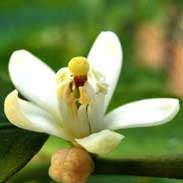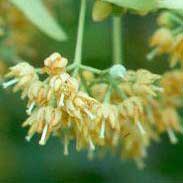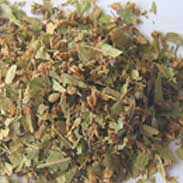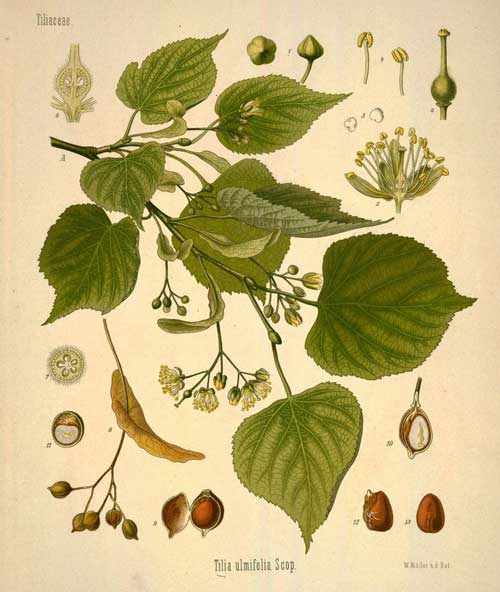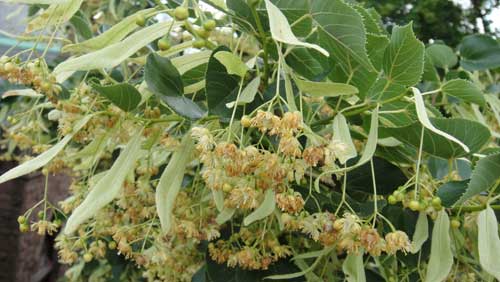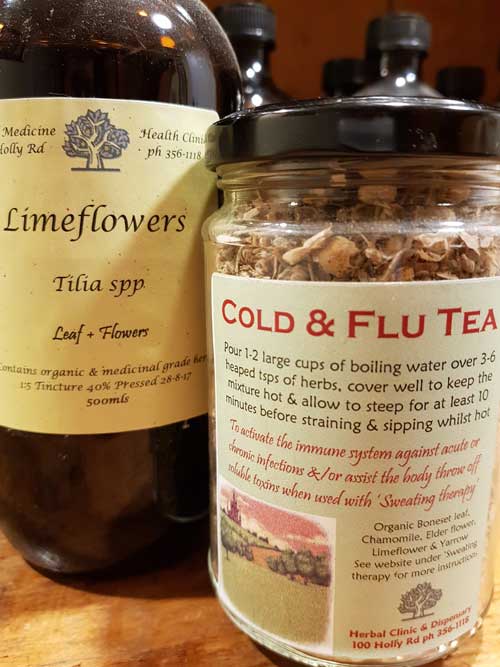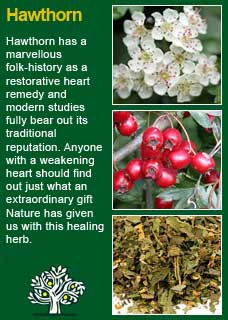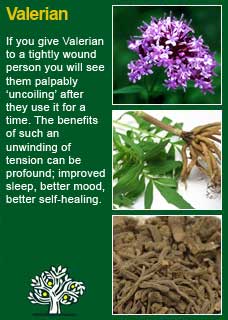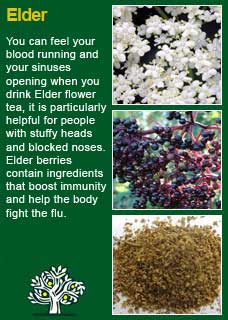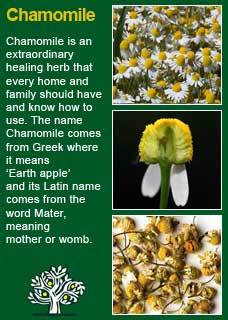
|
|
||||
| Our Pages ABOUT CONSTITUTIONAL MEDICINE
|
The leaves and flowers of the Limeflower tree, or Lindenflower tree, which will be recognised by most people in the modern world because they are such a popular tree to plant in avenues, parks or gardens. Limeflower trees are tall and hardy and their graceful branches burst out in an abundance of sweet-smelling flowers every year.
Limeflowers have been historically used for treating heart related problems such as throbbing headaches, high blood pressure and shortness of breath. They are highly regarded for improving sleep and helping with tension and anxiety. Limeflowers have also been widely used in children’s medicine for problems such as restlessness, irritability, fevers, aches and pains. Simon Mills writes 'Limeflowers are a gentle but effective relaxant especially for children and for those suffering from nervous irritability; and as an important herb in fever management'. T J Lyle writes 'the flowers of this tree are a gently stimulating, soothing, diffusive tonic, influencing the circulation, and mucous membrane especially of the respiratory tract, and will be found useful in hot infusions in colds, coughs and eruptive diseases, bronchitis and acute catarrh' Rudolph Weiss M.D writes 'fresh Linden flower tea has a wonderful smell and taste and is therefore popular with children. Like Elder flower tea, Linden flower is also a good diaphoretic, (an agent the produces a therapeutic 'sweat') the potency of the two is approximately equal but the effect of Linden goes beyond that of a diaphoretic; it also results in general immune stimulation even if perspiration does not actually occur. Thomas Bartram describes Lime flowers as being good for headache from high blood pressure (and that it is an ingredient of blood pressure mixtures), hardening of the arteries, nervous excitability and insomnia. He says that it 'once had the reputation for reducing the severity of epileptic attacks' Chevallier writes 'Linden is an antispasmodic, sweat-inducing and sedative remedy. It relieves tension and sinus headaches, helping to calm the mind and allow easy sleep. Linden is an excellent remedy for stress and panic, and is used specifically to treat nervous palpitations' The British Herbal Pharmacopoeia (BHP) describes the actions of Lime flowers as 'sedative, spasmolytic, diaphoretic, diuretic, mild astringent' It says it is indicated for 'raised arterial pressure associated with arteriosclerosis and nervous tension'. The BHP suggests combining it with Hawthorn for high blood pressure, with Hops for the nervous system and with Elder in the common cold. The BHP recommends a dose of 2-4 grams by infusion and the tincture at 1:5 in 45% ethanol at a dose of 1-2 mls.
~ A particularly brave (or perhaps just well-paid!) group of volunteers were willing to have an artificially induced skin-abrasion from which wound an external application of Limeflowers was shown to speed the healing (Fleischner AM: Cosmet 100:54-55, 1985) ~ In laboratory studies an extract of Limeflowers was shown to reduce anxiety (Aguirre-Hernandez E, Martinez AL, Gonzalez-Trujano ME, Moreno J, Vibrans H, Soto-Hernandez M. Pharmacological evaluation of the anxiolytic and sedative effects of Tilia J Ethnopharmacol. 2007;109(1):140-145) and likewise a sedative effect was obtained when it was inhaled as an essential oil (Buchbauer G, Jirovetz L. Jager W: Arch Pharm 325(4):247-248, 1992) ~ The authors, titles and the 'where-and-when' published of several other studies and articles on Limeflowers are listed in a PDF found here
For some years now, against this proven and safe way of herbalism, there has been a rising tide of excessive caution and scare-mongering in many parts of the world. The same authorities that, not so long ago, decried herbal medicines as ineffectual, have now taken up a different adversarial position; that they are dangerous substances that should only be prescribed by Doctors, who of course have zero training in them. Unfortunately, the same unnecessary fear and worry has crept into many natural health websites and popular publications on herbs. Herbs that we have safely used for thousands of years, that have no reports of adverse reactions in the medical literature despite widespread use by millions of people, are suddenly described as contraindicated because of something that should have been seen as completely unimportant, or at the utmost a merely theoretical concern, such as a laboratory study on one of the herb's constituents to use an all too common example. I wonder sometimes if the writers of such articles feel that the herb will be more deserving of respect if it is thought to be a little bit dangerous, in other words more like a drug than something that has simply come out of the earth and been used by ordinary people for generations beyond count. There is just so much misinformation about herbal medicine on the internet now. Ludicrous claims and cautions abound in equal measure; it seems like one group are trying to make money out of the public whilst the other are busily trying to scare them off. I have to believe that the kind of reader who takes the time to read pages on herbs that are as extensive as this one is much less likely to be swayed by marketers or misinformers. I hope that you will keep your wits about you if you get conflicting opinions from people who have never really got to know these herbs, who have never worked with them, or learned how to use them safely and effectively. I want to remind you that the reason that herbs can never be patented and owned by any individual or corporation is because they are, and always will be, the People's medicine. They belong to all of us and it is my great hope in sharing this work that you will learn how to use them wisely for yourself, and the people you care for. Be safe, but do not be afraid.
Limeflowers are marvellously pretty and pleasant and, especially when looking at the long traditional use as a medicine for children, it could be easy to side-line this herb as something safe, sweet but rather mild. They are mild, and safe, but these gentle leaves and flowers bely a deceptive strength that can be seen in their origin; the majestic Linden tree itself. If you who are reading this are studying herbal medicine or maybe you just have your own reasons to want to know this plant ally at a much deeper level then I encourage you to make a cup of Limeflower tea, or take a small dose of its tincture, and then, with a quiet and attentive mind, observe for yourself how it makes you feel... Speaking for myself it has been this ancient method of experiential learning, as well as a great deal of using it with diverse people that has led me to come to observe and feel that there is a deep power inside this harmless herb. Its action is supremely gentle but at the same time, when it is the right herb for the right person, it can help shift a stuck pattern of deeply held tension inside their very heart. Further to this, if you would like to learn more about the ancient art of pulse testing, a simple but powerful way to ask the intuitive intelligence of the body for its responses to a herb by feeling the pulse whilst giving a tiny dose by mouth, read here It can be seen how Limeflowers can relax constricted blood vessels in a feverish child remarkably quickly. What can also be observed is that, if given patiently to an adult, it can also relax the tightening in their blood vessels that gives such dangerous problems as high blood pressure or such troublesome symptoms as vascular headaches or restless legs and general agitation. Limeflower tea can work straight away for a child or an adult with a fever but to get the action on the heart and blood vessels its influence must be sustained for weeks, if not months, to make a lasting shift to a stuck pattern of vascular and nervous tension. Limeflowers combine perfectly with Hawthorn and Valerian to help heart health problems and with Elder and Chamomile for colds, flu's and many other common children's health problems. A couple of examples of how I typically use it are shown below
This would make 560mls, which will just fit into a 500ml amber pharm round. Bearing in mind that these are all tinctures that we make ourselves from dried organic herbs, so the equivalent dose might be higher or lower from a different practitioner or company, I would use about 8-10 mls of this once a day to improve heart and artery health, blood pressure, circulation etc. If a person was in a bad way with heart based symptoms, I would not hesitate to go to the maximum dose of 10mls twice a day until they were clearly much better, before going back to a smaller maintenance, or preventative medicine, once a day dose. *If for reasons of personal preference, or because their blood pressure was sensitive to it (which is only notable in some cases) the Licorice root was not desired in the mixture, then it could be substitured for Fennel, or Peppermint, or even Chamomile for a pleasant tasting 'adjuvant' to the medicine.
The dosage to have a pronounced effect is to pour one to two large cups of freshly boiled water over 3-6 hpd tsps, or about 4-8 grams of the herbs. Cover and allow to steep for at least 10 minutes, longer is ok too. When ready to drink it, strain and sip whilst hot. The taste of this tea is strong but quite acceptable and there has been excellent feedback from many people as to how well it has helped to activate the immune system to break out of acute or chronic infections. It can be safely taken by anyone from any age. More about 'sweating therapy' a method to use this tea in conjunction with creating a 'therapeutic fever' is found here Much of the information here about the traditional uses of Limeflowers is consistent with the model of thinking whereby one may treat problem A with plant B. There is value in this approach, especially in how it helps us pass on useful knowledge to one another, but it falls short in one vital area; and that is that people are not all cut from the same cloth! Something that works brilliantly for one person may do less for another -- why is this? Part of the reason is that people vary in their constitutions as to whether they are either hotter or cooler and, at the same time, either dryer or damper. This useful and rather fascinating subject is introduced further here Another big part of using the right herb when it is most needed comes from understanding the need to treat what is going wrong for the person that had led up to their getting a health condition. In this light, Limeflowers can particularly offer its benefits when a relaxing action is needed in the 'cycle of healing', more about this here
Please understand that I cannot advise you, including on products or dosage, without seeing you in person in my clinic but for ideas
on how you might find a good herbalist in your area read here |
|
|
© 2011 R.J.Whelan Ltd
